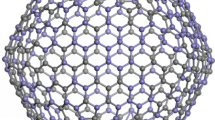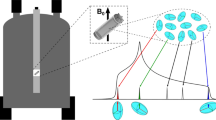Conclusions
-
1.
The 3-trifluoroacetylcamphorates of Pr and Dy are dimeric in C6H6 and CCl4.
-
2.
According to the data on the paramagnetic birefringence effect, the conformation of the ligands surrounding the central ion in Pr2(facam)6 and in Dy2(facam)6 can be described by an octahedron. The same form is also characteristic of the monomer of Dy(facam)3. In the case of the monomer of Pr(facam)3, a structure which is intermediate between a prism and an octahedron is realized.
Similar content being viewed by others
Literature cited
S. G. Vul'fson, V. F. Nikolaev, N. V. Utyaganov, et al., Izv. Akad. Nauk SSSR, Ser. Khim., 2673 (1985).
S. G. Vul'fson, V. F. Nikolaev, N. V. Utyaganov, et al., Izv. Akad. Nauk SSSR, Ser. Khim., 2274 (1984).
M. S. Beevers and D. A. Elliot, Mol. Cryst. Liq. Cryst.,53, 111 (1979).
J. M. Eckert and R. J. W. Le Fevre, J. Chem. Soc., 2356 (1961).
M. V. Vol'kenshtein, Molecular Optics [in Russian], Gostekhizdat, Moscow-Leningrad (1951).
V. T. Kalinnikov and Yu. V. Rakitin, Introduction to Magnetochemistry, Measurements of the Static Magnetic Susceptibility in Chemistry [in Russian], Nauka, Moscow (1980).
W. W. Horrocks, J. J. P. Sipe, and D. Sudnick, in: NMR Shift Reagents, Academic Press, New York (1973), p. 53.
C. S. Erasmus and J. C. A. Boeyens, Acta Crystallogr., Sec. B,26, 1843 (1970).
A. N. Vereshchagin, The Polarizability of Molecules [in Russian], Nauka, Moscow (1980).
R. J. W. Le Fevre, Proc. Chem. Soc, 283 (1958).
W. W. Horrocks and J. J. P. Sipe, Science,177, 994 (1972).
D. L. Kepert, Inorganic Chemistry Concepts, Vol. 6: Inorganic Stereochemistry, Springer-Verlag, Berlin (1982).
S. Shibata, K. Iijima, T. Inuzuka, et al., J. Mol. Struct.,144, 351 (1986).
P. J. Styles, Mol. Phys.,15, 405 (1968).
V. Shurig, Inorg. Chem.,11, 736 (1972).
G. G. Butenko, Dipole Moments in Organic Chemistry [in Russian], Izd. Kazanskogo Univ., Kazan' (1980).
Author information
Authors and Affiliations
Additional information
For previous communication, see [1].
Translated from Izvestiya Akademii Nauk SSSR, Seriya Khimicheskaya, No. 2, pp. 345–350, February, 1988.
Rights and permissions
About this article
Cite this article
Abdullin, I.R., Vul'fson, S.G., Kazakova, E.K. et al. Phenomenon of magnetic birefringence in solutions of paramagnetic substances. 3. Structure and paramagnetic anisotropy of the 3-trifluoroacetylcamphorates of praseodymium and dysprosium. Russ Chem Bull 37, 268–273 (1988). https://doi.org/10.1007/BF00957424
Received:
Issue Date:
DOI: https://doi.org/10.1007/BF00957424




